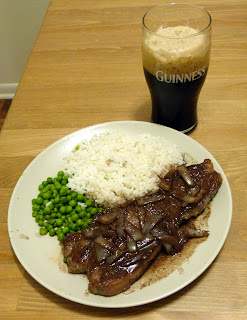Chicken Tikka Masala is one of the most popular Indian dishes worldwide, especially in Britain. The origins of the dish are unclear, but one story says it originated in an Indian restaurant in Scotland. Everyone has their own recipe for Chicken Tikka Masala, and I devised my own after some extensive research. What everyone does agree on is the basic construction of the dish - chicken tikka and a tomato cream sauce. Chicken Tikka is a an Indian dish of marinated chicken pieces roasted in a Tandoori oven. Of course, I don't have one of those, so I substitute my handy broiler.
The chicken tikka by itself is very tasty, and I encourage you to take a bite before submerging it in the sauce. Overall, you'll notice that the flavors are a lot more nuanced than the
quick-and-easy chicken curry I did before. This is a dish that is one must nurture, and it is well worth it. In terms of ingredients, this is by far the most sophisticated recipe to appear on
No Free Lunch so far. Don't be intimidated, however, by the long list of spices. This is by no means a definitive recipe; go with what you have if you're missing something here or there. That said, the flavors come together beautifully - the acidic citrus from the lemon, the fragrant cinnamon, the spicy cayenne pepper, and all the rest make for a delicious treat.
Ingredients
Chicken Tikka
- 2 split chicken breasts
- 1 cup plain yogurt
- 2 tsp cumin
- 1/2 tsp cayenne pepper
- 1 tsp cinnamon
- 1 tsp coriander
- 1/2 tsp cardamom
- 1 tsp black pepper
- 2 tsp salt
- 1/2 lemon
Tomato Cream Sauce
- 2 cloves garlic, minced
- 1/2 onion, diced
- 1 cup crushed tomatoes
- 1 cup cream
- 1 tsp coriander
- 1 tsp cumin
- 1 tsp turmeric
- 2 tsp paprika
- 1 1/2 tablespoons butter
Instructions
Cut the bone and skin off the chicken, then cut into small pieces, about an inch a side. Don't be afraid to get your hands dirty here, it's messy work. Combine the yogurt, spices, and chicken in a large bowl or Ziploc bag. Squeeze the lemon juice into the bowl and mix thoroughly. Cover and refrigerate for one hour. Use this time to cook some basmati rice and to get the sauce started. It is worth noting here that due to the shape of the grain, basmati rice only takes about 15 minutes to cook fully.
Once the chicken is done marinating, place the pieces on a sheet pan and shake off excess marinade. Broil until cooked through. Since we cut up the chicken into small pieces, this takes less than 10 minutes. You may want to flip the chicken after a few minutes to cook evenly. The marinade will keep the chicken juicy and tender.
Melt butter in a large pot on medium heat. Add the onion and garlic and sauté until onions are softened. Add the spices and stir. Pour in the crushed tomatoes and simmer for a few minutes. Stir in the cream. The sauce will now take on the brownish-orange color we all know and love. Simmer and reduce for about 10 minutes, then add the chicken pieces. Taste the sauce and add salt and pepper as needed. Simmer for a few more minutes all together. Serve with basmati rice. A great drink accompaniment is an English dry cider.















































